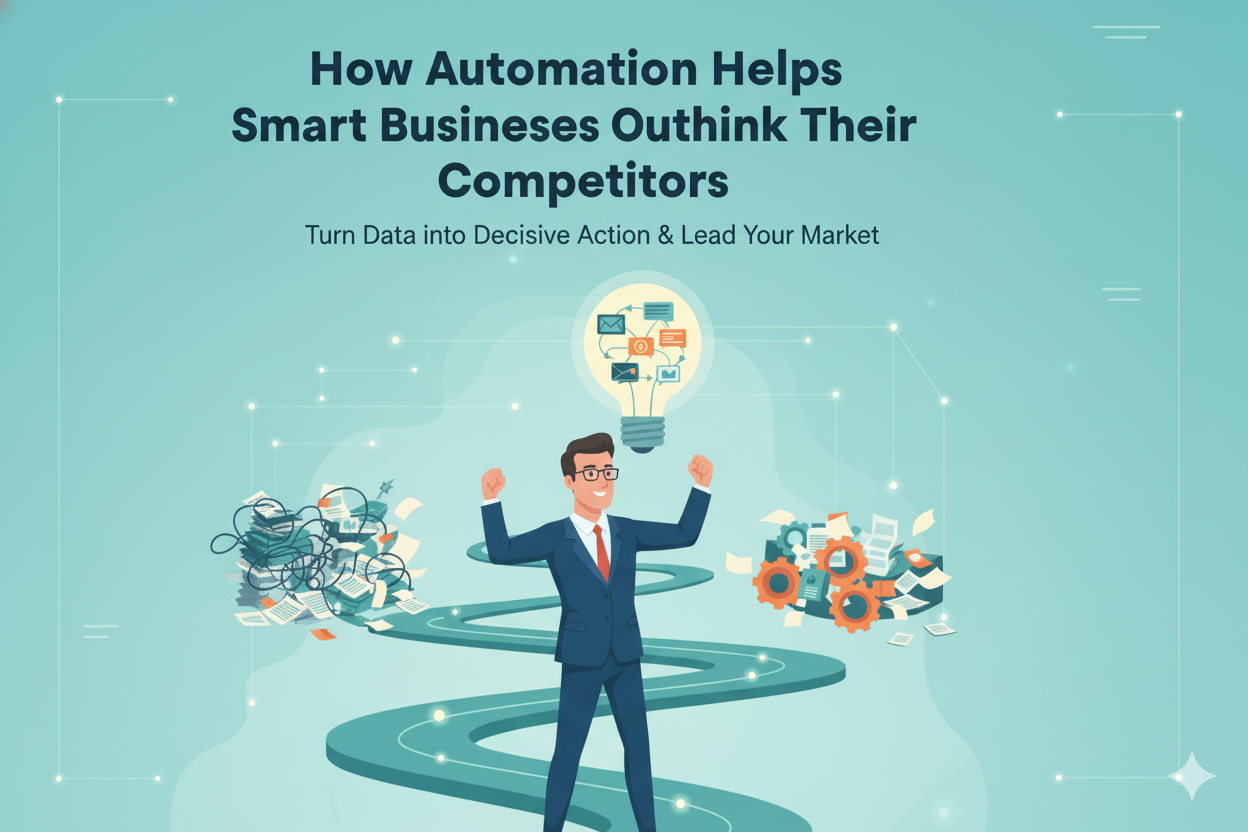
Table of Contents
Estimated reading time: 6 minutes
In business, speed and precision define who wins. The companies that stay ahead aren’t necessarily bigger — they’re simply smarter at using data.
Intelligent automation gives growing businesses that advantage. It collects and organizes the information you need to make faster, more confident decisions — about pricing, offers, customer needs, and new opportunities.
But automation alone isn’t the solution. The real edge comes from combining automation with strategic analysis. Automation gathers the data; the expert interprets it. This partnership — technology plus human insight — is what turns efficiency into profit.
Understanding the Opportunity — The “Arbitrage”
Every market hides a gap between what businesses know and how fast they can act on it. That gap is the opportunity.
Intelligent automation closes that gap by processing information faster and cheaper than traditional manual methods. This creates what we call administrative arbitrage: using technology to out-analyze competitors who still rely on guesswork.
For example, while most companies spend hours collecting competitor information or customer feedback, an automated system can do that continuously — allowing you to focus on what it means and what to do next.
According to Gartner, 80 % of executives believe automation can support any business decision. In other words, automation isn’t just about saving time — it’s about enabling sharper, data-driven choices at every level.
Pillar 1 – Competitor Tracking & Industry Signals
The first data source focuses on what’s happening in your market.
Automating competitor and industry tracking can uncover:
- Which offers or campaigns are running successfully — and for how long.
- Where competitors are investing (e.g., ads, product bundles, content topics).
- Which services they quietly retire — revealing what’s not working.
By monitoring these signals automatically, you see patterns others miss. You can quickly identify which strategies are worth testing and which ones to avoid.
This kind of visibility turns reactive businesses into proactive strategists — you see shifts before they become trends.
Pillar 2 – Customer Voice & Forum Insights
The second data stream focuses on what your customers are saying.
Forums, social media, and comment sections are filled with unfiltered feedback — what people want, what frustrates them, and what’s missing.
Automation can collect and categorize these conversations, helping you discover:
- Repeated pain points (e.g., “I spend hours editing my videos every week”).
- Unmet needs (“No one offers this service for smaller creators”).
- Common requests (“I wish my editor handled captions too”).
This information reveals where demand already exists but supply is weak. When you combine that insight with your competitor tracking, real opportunity emerges.

Finding the Strategic Gap
When you merge market signals (Input A) with customer voice (Input B), patterns appear:
- Customers repeatedly ask for solutions competitors don’t offer.
- Certain services perform well but are poorly packaged.
- New trends emerge faster than others can adapt.
That overlap — high demand, low competition — is your Profit Gap.
For example, if creators complain about how long content distribution takes, but no competitor offers a solution, that’s a service gap waiting to be filled.
Automation surfaces these insights in real time, letting you respond while competitors are still guessing.
Finding the Strategic Gap
Automation is powerful only when structured correctly. That’s where expert setup matters.
Here’s the simple model:
- Collection – Automatically gather competitor and customer data from selected sources (websites, forums, social feeds).
- Analysis – Organize and evaluate the information to spot recurring patterns, keywords, and emerging opportunities.
- Output – Generate clear reports or dashboards highlighting actionable insights — like “Rising Demand Topics” or “Untapped Services.”
We build these systems using low-code tools such as Airtable, Make, and OpenAI — flexible platforms that don’t require heavy IT resources.
According to Gartner, most organizations are now building “fully automated value chains” because it allows them to act faster and stay lean.
Automation handles the repetition; analysis provides direction. Together, they form a smarter, more responsive business engine.
You can see exactly how to build this kind of automation in my step-by-step video tutorial: Watch Here
Conclusion & Key Takeaways
Smart businesses aren’t just working harder — they’re working intelligently.
By pairing automation with expert analysis, you can:
- Turn scattered data into strategic clarity.
- Identify profit gaps before competitors notice them.
- Run leaner operations without losing insight.
- Scale decision-making without scaling overhead.
Automation handles the heavy lifting, but the analyst creates the advantage. When you design systems that think faster than your competitors, you stop reacting and start leading.
FAQ
▸ 1. Do I need a big technical team to use automation?
No. Low-code platforms make setup simple. What matters is having a clear strategy and someone who can interpret the results.
▸ 2. How quickly can I see results?
Most small businesses start spotting opportunities within 30–60 days once the workflows are active.
▸ 3. Is automation expensive to maintain?
Not at all. The real investment is upfront design and calibration. After that, it runs quietly in the background.